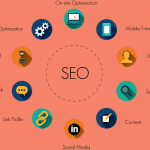Your website looks stunning, your content resonates with your audience, yet organic search traffic remains stubbornly flat. The culprit? Hidden technical barriers preventing search engines from properly crawling, indexing, and ranking your site. While beautiful design and compelling web content attract human visitors, technical search engine optimization determines whether those visitors ever find you through Google Search. Understanding the technical foundation—from site speed and structured data to mobile optimization and website architecture—transforms invisible sites into high-performing digital assets that dominate search rankings while delivering exceptional user experience.
What Technical SEO Actually Means
Technical SEO encompasses the behind-the-scenes elements that help search engine crawlers access, understand, and index your website efficiently. Unlike on-page SEO focusing on content quality and target keywords, or off-page factors like inbound links from authoritative websites, technical SEO addresses the infrastructure enabling search engines to process your site effectively.
Think of it this way: quality content and relevant content represent your message, while technical SEO provides the delivery system ensuring that message reaches your target audience through search results. Without proper technical foundation, even exceptional high-quality content remains invisible regardless of how well it serves user intent.
Moreover, technical SEO directly impacts business outcomes beyond just search rankings. Faster site speed improves user experience reducing bounce rates, mobile optimization captures consumers browsing on mobile device, and proper indexing ensures all valuable pages contribute to your online presence. Consequently, investing in technical search engine optimization delivers measurable returns through increased visibility, higher search traffic, and better conversion rates.
Core Web Vitals and Site Performance
Google prioritizes user experience as a ranking factor, specifically measuring Core Web Vitals—metrics quantifying how quickly pages load, how stable they remain during loading, and how responsive they feel to user interaction. These performance indicators directly influence where your site appears in search engine results.
Key Performance Metrics:
Largest Contentful Paint (LCP): Measures loading performance. Your page should render main content within 2.5 seconds. Slow LCP frustrates users who abandon sites that spend too long loading, directly impacting your search traffic and business outcomes.
First Input Delay (FID): Quantifies interactivity. Pages should respond to user clicks within 100 milliseconds. Laggy responses create poor user experience that search engines penalize through lower rankings.
Cumulative Layout Shift (CLS): Tracks visual stability. Elements shouldn’t shift unexpectedly as pages load, preventing users from accidentally clicking wrong links or buttons due to content movement.
Improving Site Speed:
Several factors influence performance requiring strategic attention:
- Optimize Images: Compress images without sacrificing quality, implement lazy loading so images load only when users scroll to them
- Content Delivery Network: Use CDN services distributing content across global servers, reducing distance between users and your site
- Minimize Code: Remove unnecessary code, minify CSS and JavaScript files
- Enable Caching: Store frequently accessed files locally in user browsers, reducing server requests
- Choose Quality Hosting: Invest in hosting services providing adequate resources for your traffic volumes

Tools like Google PageSpeed Insights and PageSpeed Insights provide detailed analysis identifying specific issues slowing your site. These tools generate actionable recommendations with clear priorities, creating straightforward plans for improvement. Furthermore, monitoring these metrics through your dashboard ensures ongoing optimization rather than one-time fixes.
Additionally, site speed impacts mobile device users particularly severely, as they often browse on slower connections. Since mobile searches now dominate search queries across most industries, mobile optimization becomes non-negotiable for maintaining competitive search rankings.
Mobile Optimization Essentials
Over 60% of search traffic originates from mobile device users, making mobile optimization critical for visibility in search results. Google implements mobile-first indexing, meaning it primarily uses mobile versions when evaluating and ranking sites in its search index.
Mobile-Friendly Requirements:
Responsive Design: Your site must adapt seamlessly across different screen sizes without requiring separate mobile sites. Responsive themes automatically adjust layouts, ensuring content remains readable and navigation stays functional regardless of device.
Touch-Friendly Navigation: Buttons and links need adequate spacing preventing accidental clicks. Mobile users interact through touch rather than mouse precision, requiring larger click targets and simplified navigation structures.
Readable Text: Font sizes should remain legible without zooming. Users abandoning sites requiring constant pinching and zooming to read content signal poor user experience that search engines recognize and penalize.
Testing Mobile Performance:
Google provides Mobile-Friendly Test tools evaluating how well pages perform on mobile device. These tools identify specific issues like text too small, clickable elements too close together, or content wider than screens. Furthermore, Google Search Console reports mobile usability issues across your entire site, allowing systematic resolution rather than page-by-page fixes.
Additionally, consider how consumers actually use mobile search. They often seek immediate information with intent to take action—calling businesses, getting directions, or making purchases. Therefore, ensure contact information, services descriptions, and calls-to-action remain prominently accessible on mobile layouts.
Crawling, Indexing, and Site Architecture
Before your site appears in search results, search engine crawlers must discover pages, understand content, and add them to Google’s search index. Technical SEO ensures this process works efficiently, maximizing your site’s visibility while respecting crawl budget limitations.
Crawl Budget Optimization:
Search engines allocate finite resources to each site based on factors including site authority, update frequency, and technical health. Crawl budget represents how many pages search engine crawlers will process during visits. Consequently, sites must prioritize important pages while preventing crawlers from wasting resources on low-value content.
Essential Crawling Elements:
XML Sitemap: Submit XML sitemap through Google Search Console providing search engines with comprehensive site maps showing all important pages, their hierarchies, and update frequencies. This sitemap guides crawlers ensuring they discover all valuable content rather than missing isolated pages lacking adequate internal links.
Robots.txt File: This file instructs search engine crawlers which pages to crawl and which to ignore. Use robots.txt preventing crawlers from accessing duplicate content, thank-you pages, admin areas, and other pages that shouldn’t appear in search results. However, configure carefully—blocking important pages accidentally creates visibility problems requiring correction.
Website Architecture:
Logical site structure helps both users and search engines navigate effectively. Well-organized website architecture creates clear hierarchies with homepage linking to main category pages, which then link to specific service or product pages, further connecting to detailed blog posts or case studies.
Architecture Best Practices:
- Keep important pages within three clicks from homepage
- Use descriptive URLs reflecting page content and hierarchy
- Implement breadcrumb navigation showing users their current location
- Create logical internal linking structures connecting related content
- Avoid orphan pages lacking any internal links leading to them
Moreover, proper architecture distributes “link equity” throughout sites, ensuring authority flows from high-traffic pages to deeper content requiring visibility. This internal linking strategy complements external inbound links from reputable websites, collectively boosting search rankings across your entire domain address.
HTTPS, Security, and Trust Signals
Google explicitly identifies HTTPS as a ranking factor, making secure connections essential for competitive search rankings. Beyond SEO benefits, security builds trust with users increasingly aware of online privacy and data protection.
Security Implementation:
Implement SSL certificates converting sites from HTTP to HTTPS protocols encrypting data transmitted between servers and user browsers. This encryption protects sensitive information during form submissions, logins, and transactions. Furthermore, browsers prominently display security warnings when users visit non-secure sites, creating immediate trust issues damaging credibility.
Additionally, ensure sites load properly via HTTPS without mixed content warnings caused by loading some resources (images, scripts) through non-secure HTTP connections. These warnings undermine security benefits while potentially impacting rendering and user experience.

Structured Data and Schema Markup
Structured data using schema markup helps search engines understand page content beyond simple text analysis. This markup provides explicit context about businesses, products, services, reviews, events, and countless other content types, enabling enhanced display features in SERP.
Schema Markup Benefits:
Implementing schema markup can generate rich snippets—enhanced search results displaying additional information like star ratings, pricing, availability, or event dates. These visually prominent listings attract more clicks compared to standard results, improving click-through rates even without higher rankings.
Common Schema Types:
- LocalBusiness: Provides business information for local search results
- Product: Details product specifications, pricing, availability, and reviews
- Article: Identifies blog posts and news content
- FAQ: Structures frequently asked questions with answers
- Review: Highlights customer ratings and testimonials
- Event: Promotes webinars, conferences, or other events
JSON-LD represents the preferred format for implementing structured data, allowing marketers to add markup without disrupting visible content. As part of Technical SEO, tools are used to validate schema, ensuring proper implementation that search algorithms can process correctly. Furthermore, Google Search Console reports structured data errors requiring correction to maintain optimal Technical SEO performance.
Technical SEO Elements Checklist
Critical Components:
Title Tags: Unique, descriptive titles under 60 characters incorporating target keywords naturally while accurately describing page content. These appear as clickable headlines in search results, directly influencing whether users click through.
Meta Descriptions: Compelling summaries under 160 characters encouraging clicks from search results. While not direct ranking factors, meta descriptions impact click-through rates affecting overall search traffic volumes.
Canonical Tags: Specify preferred versions when duplicate content exists across multiple URLs, preventing search engines from splitting ranking signals across similar pages.
Image Optimization: Use descriptive file names and alt text helping image search while improving accessibility. Compress images maintaining quality while reducing file sizes improving site speed.
Broken Links: Regularly audit sites identifying and fixing broken links creating poor user experience while wasting crawl budget. Tools like Screaming Frog systematically check all links reporting errors.
Duplicate Content: Identify and resolve duplicate content issues confusing search engines about which versions to rank. Use canonical tags, 301 redirects, or content consolidation addressing duplication.
Essential Technical SEO Tools
Google Search Console: Free tool providing invaluable insights into how Google views your site. Monitor indexing status, crawl errors, search queries driving traffic, and mobile usability issues. This dashboard becomes central to ongoing SEO strategy informing prioritization and measuring improvements.
Google PageSpeed Insights: Analyzes page performance providing specific recommendations with priority levels. Test both mobile device and desktop versions identifying platform-specific issues.
Screaming Frog: Desktop application crawling sites like search engine crawlers, identifying technical issues including broken links, duplicate content, missing metadata, and redirect chains. The site profile generated reveals problems requiring attention.
Semrush: Comprehensive platform offering site audits, competitor analysis, keyword research, and performance tracking. Technical audits identify issues across sites providing actionable recommendations with severity ratings.
Mobile-Friendly Test: Standalone tool quickly checking whether pages meet mobile optimization standards. Provides specific feedback about issues preventing optimal mobile experience.
These tools complement broader Digital marketing efforts including PPC campaigns through Google Ads, social media presence, email marketing, and content strategy execution. Furthermore, insights from technical audits inform advertising targeting, campaign development, and overall Digital strategy by revealing what consumers actually search and how they interact with sites.
Connecting Technical SEO to Marketing Strategy
Technical SEO shouldn’t exist in isolation from broader marketing and advertising efforts. Instead, it provides foundation enabling all digital initiatives to perform optimally.
Marketing Integration:
When planning campaigns, consider how technical elements support goals:
- Content Marketing: Ensure blog posts are properly indexed, load quickly, and appear in relevant search results
- Local Marketing: Optimize for local search through schema markup, Google Business listings, and location-specific content
- Social Media: Fast-loading pages improve experiences when consumers click social media links
- Email Marketing: Landing pages from email campaigns must perform technically to convert traffic
- PPC and Advertising: Advertisers spending budget on ads need landing pages delivering excellent user experience maximizing conversion
Moreover, technical SEO extends value from paid advertising spend by improving organic search traffic to same pages. Rather than relying solely on bidding for visibility, strong technical foundation captures organic traffic long after advertising campaigns end.
Why Choose LinkLumin

LinkLumin delivers specialized technical SEO services alongside custom digital marketing solutions designed specifically for businesses seeking dominant online presence in competitive markets. Our team combines deep technical expertise with strategic marketing knowledge, ensuring websites not only meet search engine requirements but also drive actual business outcomes. We provide comprehensive audits using industry-leading tools, implement systematic improvements addressing Core Web Vitals, mobile optimization, crawling efficiency, and structured data, while maintaining focus on measurable results including increased search traffic, improved rankings, and enhanced user experience. Whether launching new Websites + Marketing initiatives or optimizing existing presence, LinkLumin’s proven approach transforms technical foundations into competitive advantages across USA and Canada markets.
Conclusion
Technical SEO forms the invisible foundation determining whether beautiful websites and compelling content actually reach target audiences through search results. From site speed and Core Web Vitals to mobile optimization, crawling efficiency, website architecture, HTTPS security, and structured data—each technical element contributes to search rankings while directly impacting user experience and business outcomes. Understanding these factors and systematically addressing weaknesses are core aspects of Technical SEO, transforming underperforming sites into powerful marketing assets that generate consistent organic search traffic. When approached strategically, Technical SEO delivers compounding returns, with each improvement creating lasting competitive advantages.
Ready to Optimize Your Technical Foundation?
Contact LinkLumin today for comprehensive technical SEO audits and strategic implementation. Our specialists will analyze your site using advanced tools, identify optimization opportunities, and develop customized plans addressing technical barriers limiting performance. Don’t let hidden technical issues undermine your marketing efforts—partner with experts who deliver measurable improvements in search rankings, traffic, and business results.
Tags




